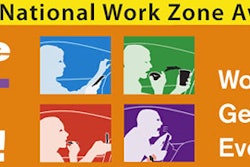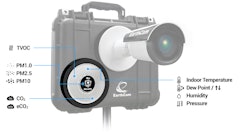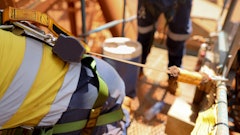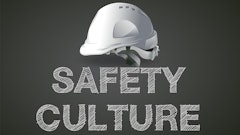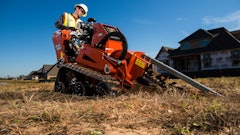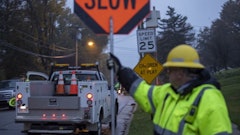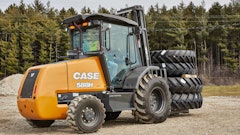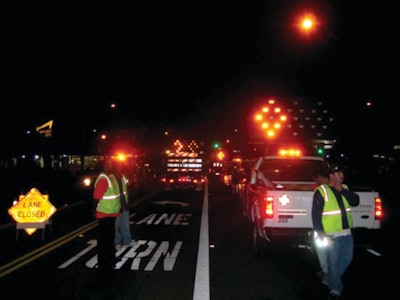
Work zone safety is crucial for a construction site of any size, and should be top of mind for the entire construction team – from project managers and supervisors, to the workers and equipment operators. More roadwork is being conducted than ever before, as new roads are built and aging infrastructures demand repairs. Increasing road congestion amidst a backdrop of evolving industry regulations that call for greater traffic safety only underscores the growing importance of work zone safety.
Although practicing the highest level of safety is the responsibility of every worker on a jobsite, having a traffic control company at job sites that require lane closures – particularly in high-speed and high-traffic areas – ensures that regulations are being followed, that the appropriate equipment is being used and that the most suitable personnel is assigned to the job. Yet, whether or not a traffic control company is on the jobsite, contractors and project managers can still implement a safety-focused work zone by building strong relationships with the project stakeholders.
Here are some work zone safety tips. In the project planning phase, start by:
Designating team leaders. Hold a pre-job team meeting with the entire team, and use this time to determine who will lead communication on behalf of the traffic control team, the contractor and the controlling agency. This will ensure that all teams are on the same page before the project begins.
Establishing good relationships with the controlling public agency. A strong relationship means you’re communicating and everything works better, which makes it safer. You would want to get on the road to set up as soon as you can, and the flexibility to start early begins with a good agency relationship. Set up “pre-warning signs” or “advanced warning signs” without breaking any regulations.
Pre-marking the work zone. This is especially valuable when setting up highway work zones. Have a job supervisor visit the work zone ahead of time and mark where signs and devices should be placed. This will make the setup process quicker and safer, leaving less room for error.
Managing time – before, during and after the project. Allow enough time to safely deploy and remove required lane closure equipment. Traffic control setup can, unfortunately, sometimes be an afterthought, and work is typically being done under a tight deadline. Setting up traffic control equipment takes time and planning, and while pre-marking the work zone will increase efficiency, this is still a time-intensive task that workers should not rush through. Mistakes can put workers and drivers in high risk for injury or death.
Using communication devices. Having the proper communication devices is critical because most work zones are noisy and workers may be setting up closures for several miles. Use radio devices that allow supervisors to provide the full traffic control team with instructions at the same time, despite outside noise and distance. Project managers can dial into the channel as well, and this will allow them to stay apprised of progress.
Special considerations for night work
Every work zone differs, whether it is the size, the weather conditions, the length of time spent on the jobsite, or the time of day the work is being completed. Nighttime projects, however, present new safety challenges that workers do not encounter during traditional working hours, and the top safety risks are related to the drivers on the roads. More impaired and fatigued drivers are on the roads at night than during the day, increasing the risk for accidents to happen.
Adding to the higher risk is the decreased level of visibility on the roads at night.
These challenging conditions call for specific worker apparel and jobsite equipment, as well as an experienced team of workers. The following are key ways to create the safest work zone possible for a nighttime construction project:
- Performance Class 3 Apparel – Workers must wear high-visibility reflective safety apparel, which most commonly includes a vest and trousers. This makes workers easier to see when drivers approach the construction zone.
- Beacon Lights – These high-beam lights attach to construction zone signage and capture the attention of drivers, alerting them that they are approaching a work zone and should proceed with increased caution.
- Reflectivity of devices – All traffic control equipment, including cones, drums and signs must use highly-reflective lights during nighttime work, alerting everyone on the road that they are approaching a construction zone.
- Proper warning sign placement – This is critical to the safety of workers and drivers. If the traffic control team is not familiar with the area, scout it in advance to anticipate any challenges this work zone may involve, preferably at the same time and on the same day of the week as the work will be taking place. Observe what the average speeds are of drivers in the area and also take note if the road is curvy or particularly rough.
- Truck Mounted Attenuators (TMAs) – Also known as “crash trucks.” These energy-absorbing devices are attached to the rear of trucks, acting as a barrier between workers and traffic. Drivers who lose control of their vehicles will first hit the TMA, which will fold and therefore absorb the impact while protecting the driver.
- Trained and experienced workers – The American Traffic Safety Services Association (ATSSA) has an extensive certification process for supervisors of highway work zones. These supervisors must be well-versed in working in high-speed conditions, and their team must also have extensive experience working in a variety of conditions. At TMI, we offer this training as well, and recommend that the traffic control team have at least five years of experience in order to work on a nighttime project.
The right apparel and equipment are helpful in making a work zone safer, but the level of safety in a work zone depends most heavily on the people involved in the project and working on the job site every day. Planning ahead for lane closures that will result from a construction project will ensure that the project team is more prepared to practice safety on the jobsite and appropriately handle any challenges that arise.
Jonathan Spano is COO for Traffic Management Inc. (TMI), located in Long Beach, CA. Learn more about TMI at trafficmanagement.com



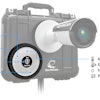
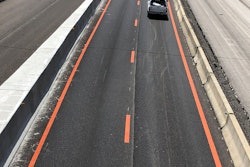
![[Video] Highway Work Zone Safety Awareness: Take Time, Stay in Control](https://img.forconstructionpros.com/files/base/acbm/fcp/image/2016/06/default.575ec0913ac51.png?auto=format%2Ccompress&fit=crop&h=167&q=70&w=250)
